I vaguely remember Bindu Mukherji. He shared my father’s passion for gardening. I remember also, as a child, visiting his enormous rose garden that lay in front of the equally enormous red brick house in George Town, Allahabad- the ancestral house he shared with his three brothers and two sisters. Like my father and many in his generation, Bindu Mukherji is no more. The house, however, still stands, lost amidst many small, gauche houses newly built on the land that was once the rose garden.
It’s occupants are Bindu da’s(‘da’ is a suffix Bengalis like me add, quite indiscriminately, to the names of males older than them. ‘Di’ is added for females) brother, Prabhash Kumar and his wife, Mira. Prabhash Mukherji and his wife lived all over India as he worked as an executive in the Bank of India until his retirement some years ago when they returned to live in this red brick house. In 2012 this house completed its hundredth year.
The double storey house is, in one word, beautiful. And very Bengali.

Prabhash Mukherji’s grand father, Bipin Bihari came to Allahabad in the late 19th century-as many Bengalis did at that time- served as judge in the High Court of Allahabad, and built this large house for himself and, quite common in those days, for his extended family. Mira di reminisces about the army of servants who worked for the large family, phaetons and later, motor cars that they used, and the many classical music soirees that used to be held in their home.
The family were also devotees of Anandmayee Ma, a prominent spiritual guru, for whom a cottage was built in the compound of their house, where she frequently came and stayed.
Among the many prominent Indians that also stayed in their house, for days at a stretch, were the great Indian Classical musicians, Ali Akbar Khan and Ravi Shankar. In fact, Bindu da himself was an accomplished classical musician, having learnt music from Ali Akbar Khan.
This picture is for all lovers of Indian classical music, including my husband- Bindu Mukherji with Ustad Ali Akbar Khan-

My sister, Uttora (who knows- or knows someone who knows- a quarter of Allahabad and arranged all this) and I walked in through the gate and into a now small yard overgrown with weed and creeper. And rising like Phoenix was the house- proud and beautiful- giving us glimpses of the splendour of the past. It was like walking into a Satyajit Ray film.
Green shutters and awnings decorate the house, doors and windows open out into what was the garden.
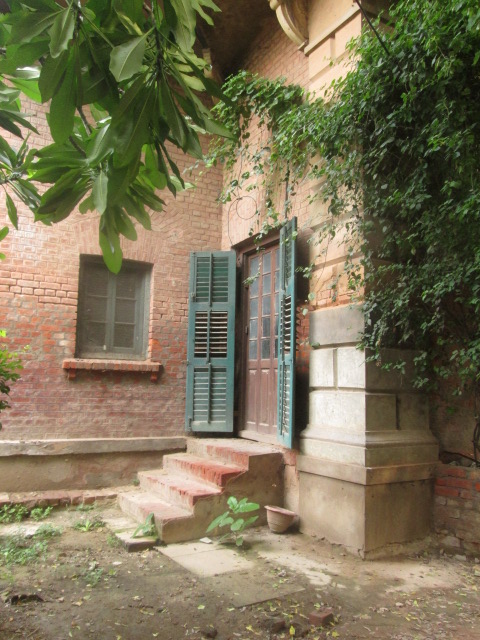
Through an elegant portico, or ‘gaari baranda'(verandah for cars), as it is called in Bengali, essential in all Indian bungalows of that time, the stone clad, small front verandah opens directly into the drawing room. Two other doors on either side open into a bedroom each.
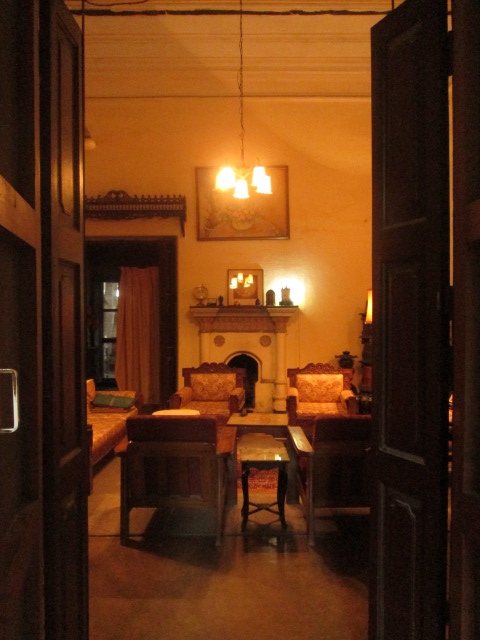
A view of a corner of the room where you can see the stunning, carved, teak wood pelmets-
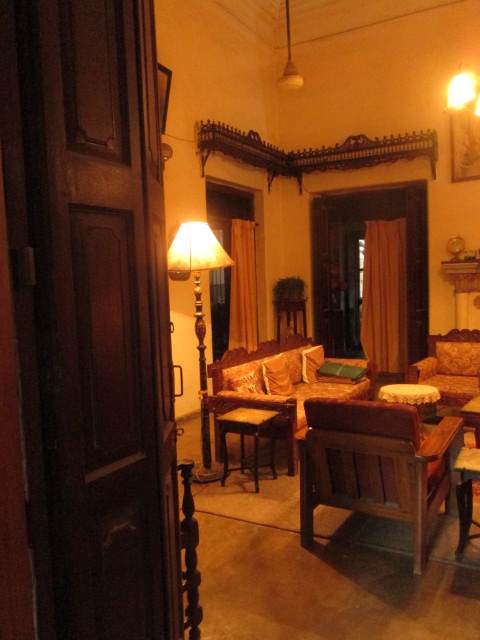
The original fireplace still used in the cold North Indian winter-

Through this room you step into a brick-clad corridor-
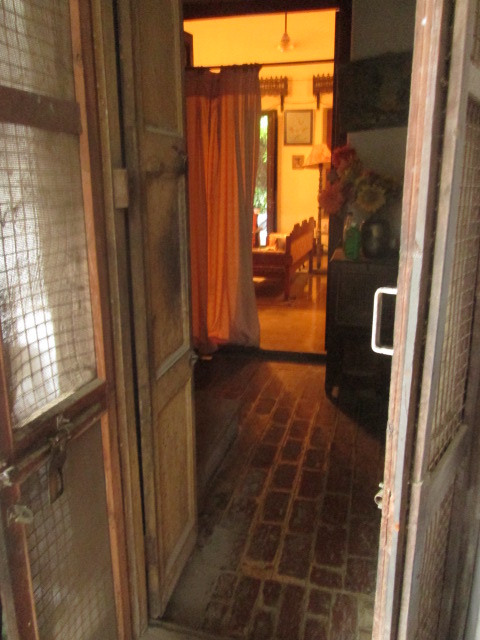
– which opens into the rear verandah and a large courtyard with mango trees.
The overgrown courtyard with an abandoned easy chair- again, giving us a glimpse of the glorious past-
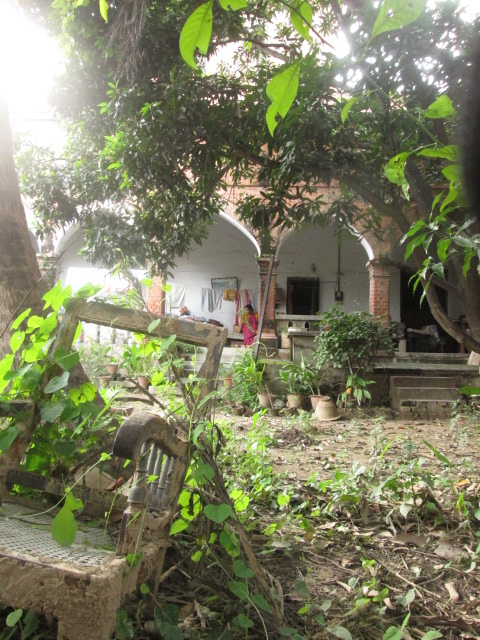
On the right of the courtyard were the large dining room and two kitchens- one for vegetarian food and the other for non-vegetarian. Now you see only a high wall there behind which are more new houses.
An English porcelain basin and an old knitting book in the courtyard- wonder who washed their hands in the basin, who followed the knitting patterns in the book, as they sat in this very courtyard-

A water fountain with a lion’s head-
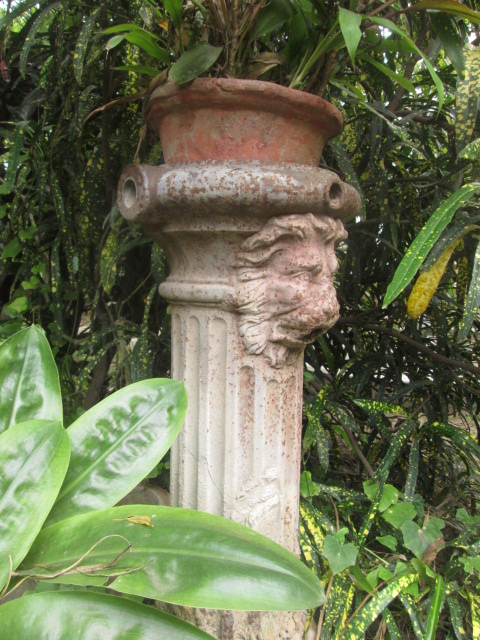
A beautiful old writing table and chair with an adjustable back.In the forefront, on a table, is a palm leaf fan- lending itself to the story-
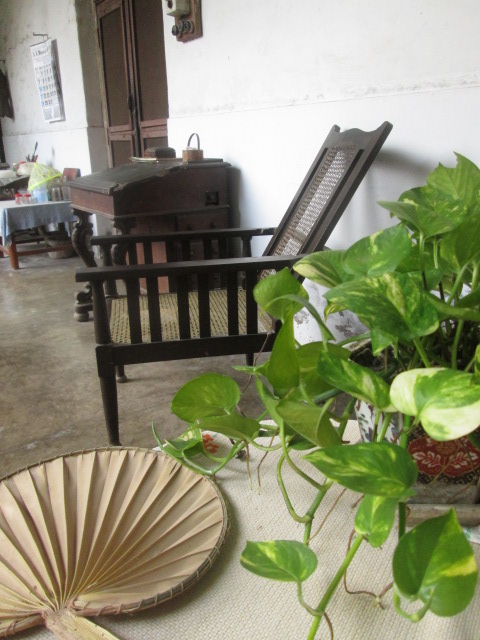
The drawing room opens into four bedrooms- two on either side. In one of the rooms, something quintessentially Bengali- twin four poster, elaborately carved teak wood beds-
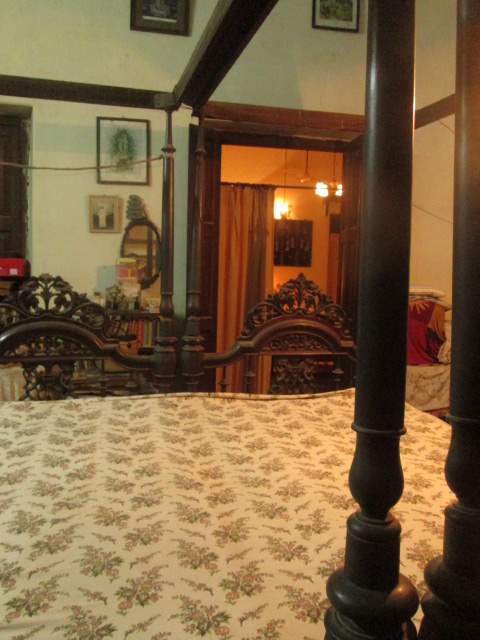
Upstairs there are six more rooms but they remain shut.
Coming to this house as a young bride, Mira di remembers being amazed by the number of people that lived in it and the even greater numbers that came and went, almost constantly. Here she is herself-
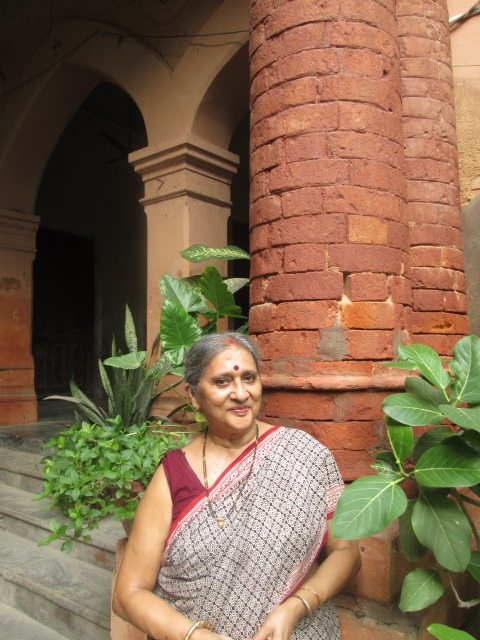
As we sat listening to Mira di and her family’s history, something else, quintessentially Bengali, arrived. It was so Bengali that I HAD to put it into this post. It was jal-khaabar or refreshments served out on individual plates- vegetable cutlets and Bengali sweets- sandesh and orange rosogolla- and excellent tea in china cups- placed befittingly on a table with cloth beautifully appliqued by Mira di’s sister-in-law and held under glass, yellowing with age-

Remembering the wonderful gentleman and his wife who built this gorgeous house- Bipin Bihari Mukherji-
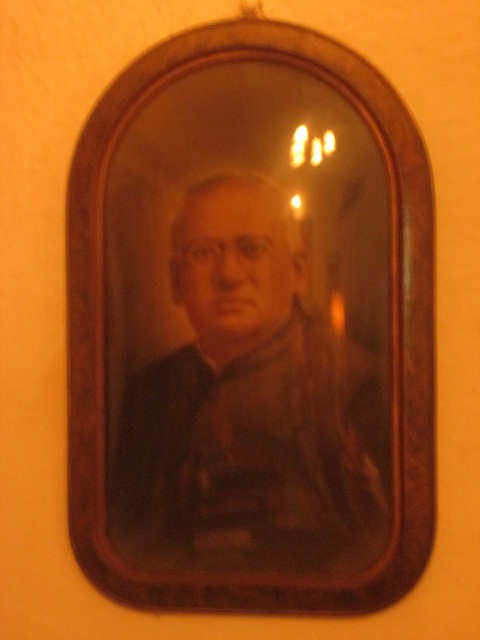
And his talented wife, Hemangini Devi-
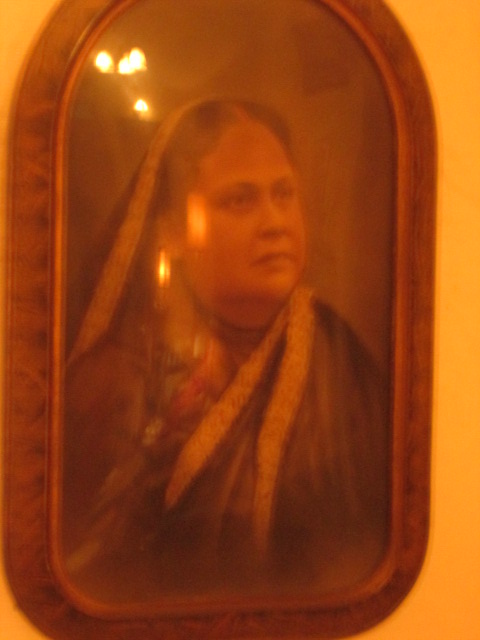
Wonder if this house moves you as much as it did me….
Tell me how you feel…

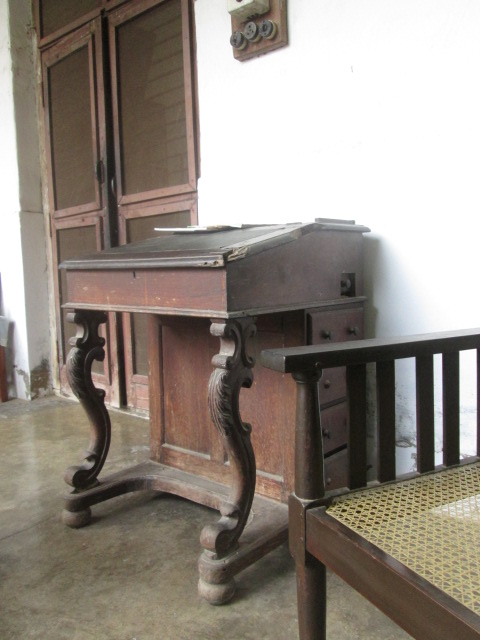
Dear Adity
It’s wonderful to read/ see the pictures of Allahabad as we knew it as children. Brings a lump to the throat. What potential but what an opportunity wasted! If only there was a vision, the city should have been one of the premier destinations in the country, thanks to the intellectual powerhouse that it once was! It benefited from years of migration during the Raj and subsequently post Independence as a seat of learning but somewhere lost its way- leading to a devastating brain drain. I constantly compare it to Bangalore, which till the 70s was perhaps smaller than Allahabad in every which way but today is India’s third city after Delhi & Bombay.
Like you say, Uttoradi knows or knows someone who knows a quarter of Allahabad- I know her well, but quarter is an understatement! She is an embodiment of the spirit that city was. A repository of anecdotes past & present. Met her in March 2013, albeit briefly. She was at her best, enjoying herself in her new role!
I grew up in George Town in one of the large compounds, playing cricket, biking, raiding guava orchards etc. There were these large bungalows all over, the boundary walls had begun to crumble but the devastation today is complete. Civil Lines is not civil anymore, Wheeler book company is disappearing like old Allahabad. Symonds is dead. Coral Club & Gymkhana of old. The roads have new names, no Elgin, Clive, Thornhill etc, replaced by today’s political reality, but it’s this dumbing down that’s irreversible, I guess. The book ‘The Last Bungalow’ captures it well. The crowd has changed, the city is different. It’s been left behind, struggling to be counted in UP’s premier cities let alone the country!
The Allahabad of the bungalows can be met in Delhi today. Lot of that crowd has moved here. It’s our loss to have lost touch with it. If we were all to give back to the city something in some way we may yet salvage something.
Thank you for your writings on a city that made us all. For giving us an opportunity again to connect with it in a way which is cerebral.
Love my Allahabad. Miss it.
Hi Vishal,Thanks for visiting and appreciating my post. I understand your sentiments,shared, I have discovered through my blog, by many others with or without an Alld connection.
I am very happy to know that young people like you want to give back something to this city that has produced special people.Any ideas on what can be done ? Perhaps you can put together a group-a pro active one-to form a forum that can preserve what is left of the city ? Intach/Unesco might have ideas. Do us all a favour-give it serious thought.
Dear Adity
It’s wonderful to read/ see the pictures of Allahabad as we knew it as children. Brings a lump to the throat. What potential but what an opportunity wasted! If only there was a vision, the city should have been one of the premier destinations in the country, thanks to the intellectual powerhouse that it once was! It benefited from years of migration during the Raj and subsequently post Independence as a seat of learning but somewhere lost its way- leading to a devastating brain drain. I constantly compare it to Bangalore, which till the 70s was perhaps smaller than Allahabad in every which way but today is India’s third city after Delhi & Bombay.
Like you say, Uttoradi knows or knows someone who knows a quarter of Allahabad- I know her well, but quarter is an understatement! She is the embodiment of the spirit that city was. A repository of anecdotes past & present. Met her in March 2013, albeit briefly. She was at her best, enjoying herself in her new role!
I grew up in George Town in one of the large compounds, playing cricket, biking, raiding guava orchards etc. There were these large bungalows all over, the boundary walls had begun to crumble but the devastation today is complete. Civil Lines is not civil anymore, Wheeler book company is disappearing like old Allahabad. Symonds is dead. Coral Club & Gymkhana of old. The roads have new names, no Elgin, Clive, Thornhill etc, replaced by today’s political reality, but it’s this dumbing down that’s irreversible, I guess. The book ‘The Last Bungalow’ captures it well. The crowd has changed, the city is different. It’s been left behind, struggling to be counted in UP’s premier cities let alone the country!
The Allahabad of the bungalows can be met in Delhi today. Lot of that crowd has moved here. It’s our loss to have lost touch with it. If we were all to give back to the city something in some way we may yet salvage something.
Thank you for your writings on a city that made us all. For giving us an opportunity again to connect with it in a way which is cerebral.
Love my Allahabad. Miss it.
Dear Adity,
What a fascinating journey into the past ! I just loved it especially because I was born in Allahabad.Keep up the good work.
Thank you,Shikha di. I am amazed how many people have an Allahabad connection ! They were either born or brought up in Alld or went to its university.
It was an interesting and a beautiful read as usual,when I see all this I almost instantly go back to the memories of my old house 138 luker gunj,had it been with us it would have also held a place of pride amongst other grandeurs of Allahabad, beautifully written and photographed and in awe of people who live there with such glorious past.how about 13 luker gunj ? Do cover it whenever possible.
Thanks. Gosh–I remember your house only too well–especially the puja room -with white sheets spread on the floor- with its windows opening out into a mango orchard. Not surprisingly, most people who lived in these bungalows were eminent and very special.
Really awesome, the thought behind this sort of a thing is great as an artist like you could only do it. The old memories linger on, of these beautiful old houses which you have captured on camera to keep it alive.
Thank you. We all have vivid memories- including those of your own house !
Really awesome, the thought behind this sort of a thing is great as an artist like you could only do it. The old memories linger on of these beautiful old houses of Allahabad which you have captured on camera to keep it alive.
Real old world charm.The bedroom without doubt proves its a Bengali home.
It does,doesn’t it ? The most ordinary of Bong homes-of the past- will have one bed which has at least some carving or detailing.
I am overwhelmed! I was born and brought up here.So was my mother.I have my mamar badi here.My husband too was born and brought up in Allahabad.We owe a lot to this town.I have bought a small apartment in Lukerganj in the hope of settling down there in my old age.No Delhi,Mumbai,Pune for us Allahabadis.
What is your mother’s family name ? A few of us still feel strongly about the smaller towns–we ourselves have chosen to return to Lucknow-to my husband’s grandfather’s house.
Her maiden name was Dey.They stayed in Lukerganj but now they have shifted to Govindnagar,a little further down towards Chakia.My mamas are all actively involved in Lukerganj Barwari where one of them is the secretary.My Boro mama Amal Dey is the director of the Agomoni.All my dadus used are or rather,were acitvely involved in dramatics and they still go regularly to Lukerganj club in the evenings.
Is your mama called Bablu da ? In which case I know him .
Yes he is!
You have to be an ”Allahabadi” to do something like you have done ,…you have turned the very same homes we have visited into a virtual heaven !! …if you are Uttara’s sister ..let me tell you .my mother in law Debmaya Banerjee wo Rajen Banerjee … & your mother were very good friends …it is sad our ancestral house in George Town is no more .. .. it could have been immortalized on your beautiful blog …instead of our in our minds.
How wonderful to hear from you, Vinita di ! Thank you so much for your appreciation–I value it. Of course I remember your beautiful house and ‘Debi di’who my mother was so fond of ! It is indeed sad that your house and many others are no more. Wish one could think of a way of preserving these. They are our legacy. Soon there will be nothing to show to our grandchildren. They will know only unimaginative box-like flats to be their legacy..
Please do keep in touch through this medium.
I was going through the memoirs of my Guru Shri Abhay and suddenly came to this chapter which talks about his association with Mr. Bindu Mukherjee. Being inspired I searched with his name on the net to find this nice blog. The book also says this house had a great library. Is it still there?
How nice to find a connection through the world of the internet ! Thank you for stopping by and putting in your comment.
It is very unfortunate that the house was sold to builders soon after I photographed it’s beauty. Of course, it has been pulled down and is now just a hole in the ground. The very good library existed on the first floor. I don’t know what happened to the books. Hope they were given to a worthy institution. I will google search Shri Abhay.
My father, Manoj Kumar Banerjee(Monu) was a great friend of Bindu (kaku)Mukherjee.
They played the guitar in a number of concerts.
It’s nostalgic reading about it all.
Hi Suparna, completely missed your comment–sorry about that ! Wow! Really nice to learn that your father knew Bindu da. Tell me, is your father Baccha and Dodai (mama)Banerjee’s brother ?